
The American Game is an American breed of game fowl, chickens bred specifically for cockfighting. It has many color varieties, and may also be kept for ornament.

The Chinese goose is an international breed of domestic goose, known by this name in Europe and in North America.

The Leghorn, Italian: Livorno or Livornese, is a breed of chicken originating in Tuscany, in central Italy. Birds were first exported to North America in 1828 from the Tuscan port city of Livorno, on the western coast of Italy. They were initially called "Italians", but by 1865 the breed was known as "Leghorn", the traditional anglicisation of "Livorno". The breed was introduced to Britain from the United States in 1870. White Leghorns are commonly used as layer chickens in many countries of the world. Other Leghorn varieties are less common.

The Dorking is a British breed of domestic chicken. It is named after the town of Dorking, in Surrey in southern England.

The Cochin is a breed of large domestic chicken. It derives from large feather-legged chickens brought from China to Europe and North America in the 1840s and 1850s. It is reared principally for exhibition. It was formerly known as Cochin-China.

The Indian Game is a British breed of game chicken, now reared either for meat or show. It originated in the early nineteenth century in the counties of Cornwall and Devon in south-west England. It is a heavy, muscular bird with an unusually broad breast; the eggs are brown.
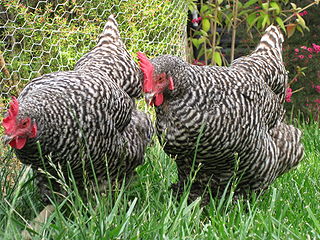
The Plymouth Rock is an American breed of domestic chicken. It was first seen in Massachusetts in the 19th century and for much of the early 20th century was the most widely kept chicken breed in the United States. It is a dual-purpose chicken, raised both for its meat and for its brown eggs. It is resistant to cold, easy to manage, and a good sitter.

The Dominique is an American breed of chicken, characterized by black-and-white barred plumage and a rose comb. It is considered to be the oldest American chicken breed, and is thought to derive from birds brought to America by colonists from southern England. It was well known by about 1750, and by the mid-nineteenth century was widely distributed in the eastern United States. It is a dual-purpose breed, but is kept principally for its brown eggs. It became an endangered breed in the twentieth century, but numbers have since recovered.
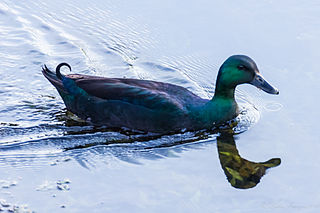
The Cayuga is an American breed of domestic duck. It was introduced to the Finger Lakes region of New York State in about 1840, and is named for the Cayuga people of that area. Until the last years of the nineteenth century it was the principal duck reared for meat in the United States. In the twenty-first century it is kept mainly for ornament.
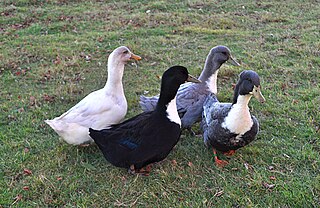
The Swedish Blue or Blue Swedish is a Swedish breed of domestic duck. It emerged during the nineteenth century in what was then Swedish Pomerania, located in present-day north-east Germany.
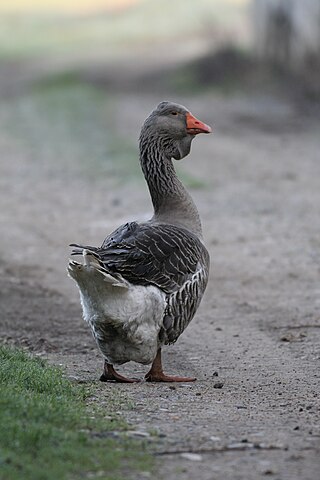
The Toulouse is a French breed of large domestic goose, originally from the area of Toulouse in south-western France. Two types are recognised: a heavy industrial type with dewlaps, the French: Oie de Toulouse à bavette; and a slightly lighter agricultural type without dewlaps, the French: Oie de Toulouse sans bavette. Both types are large, with weights of up to 9 kg. Birds bred in the United Kingdom and United States exclusively for showing may be still larger, and have a somewhat different conformation.

The New Hampshire Red or New Hampshire is an American breed of chicken. It was developed in the early twentieth century in the state of New Hampshire by selective breeding of Rhode Island Red stock; no other breed was involved. It is fast-growing, early-maturing, quick-feathering, and yields a meaty carcass. Mature birds are a light or medium red in color; they may fade in sunlight.
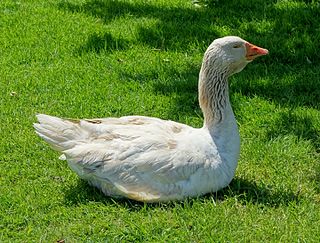
The American Buff is an American breed of domestic goose. It was accepted by the American Poultry Association in 1947. It is named for its single plumage variety, which is a pale buff or apricot-fawn in color.

The Magpie is a British breed of domestic duck. It has distinctive black and white markings reminiscent of the European magpie, and is a good layer of large eggs.

The Buckeye is an American breed of chicken. It was created in Ohio in the late nineteenth century by Nettie Metcalf. The color of its plumage was intended to resemble the color of the seeds of Aesculus glabra, the Ohio Buckeye plant for which the state is called the 'Buckeye State'.

The Silver Appleyard is a British breed of domestic duck. It was bred in the first half of the twentieth century by Reginald Appleyard, with the aim of creating a dual-purpose breed that would provide both a good quantity of meat and plenty of eggs.

A heritage turkey is one of a variety of strains of domestic turkey which retains historic characteristics that are no longer present in the majority of turkeys raised for consumption since the mid-20th century. Heritage turkeys can be differentiated from other domestic turkeys in that they are biologically capable of being raised in a manner that more closely matches the natural behavior and life cycle of wild turkeys. Heritage turkeys have a relatively long lifespan and a much slower growth rate than turkeys bred for industrial agriculture, and unlike industrially bred turkeys, can reproduce without artificial insemination.
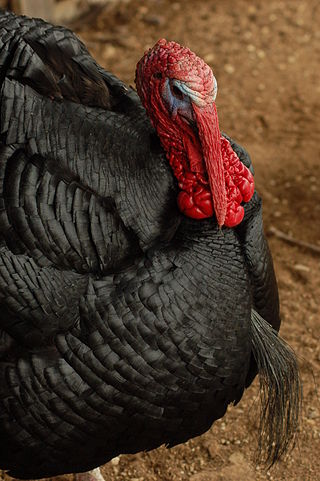
The Norfolk Black, also known as the Black Spanish or Black Turkey, is a British breed of domestic turkey. It is thought to derive from birds taken to Britain from Spain, where they had arrived with Spanish explorers returning from the New World.

The Saxony duck is a German breed of domestic duck. It was bred in Saxony in the 1930s, but because of the Second World War was recognised only in 1957.

The Onagadori is a historic Japanese breed of chicken, characterised by an exceptionally long tail. It was bred in the seventeenth century in Kōchi Prefecture, on Shikoku island in southern Japan, and was designated a Japanese National Natural Treasure in 1952. It is one of the ancestors of the German Phoenix breed.





















